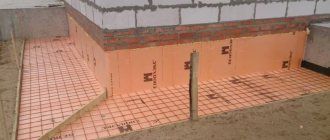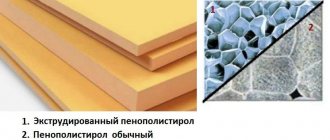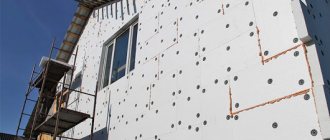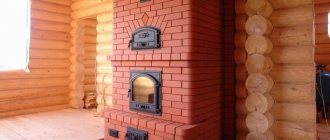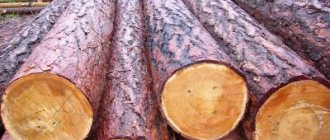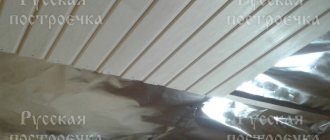In most cases, when we talk about thermal insulation materials used for insulating residential buildings, the first thing that comes to mind is mineral wool in one form or another, expanded polystyrene, expanded clay. Few people remember vermiculite, and many do not even know about its existence.
Vermiculite insulation
And completely in vain. Undeservedly given a “secondary role,” vermiculite is an insulation material of natural origin, the production of which does not use not only harmful, but also no chemical compounds at all. And, at the same time, its thermal insulation and performance qualities are not only comparable, but in some cases seriously exceed those of other widely used insulation materials. In a word, this material deserves to get to know it as closely as possible.
What is zonolite
The mineral vermiculite is actually just a raw material for the production of expanded vermiculite - zonolite, which is occasionally found in deposits. Natural vermiculite is a product of natural erosion of mica biotite from the phlogopite series of hydromicas. When they say or write that windows were made from these micas in the old days, this is not true - phlogopite micas are opaque. Before the mass production of silicate glass, windows were glazed with the almost transparent mica muscovite, which began another mineralogical series of mica. Over 90% of the world's production of top-quality muscovite came from Russia, which in the West was called Muscovy; hence the name muscovite.
Natural and expanded vermiculite (zonolite)
Vermiculite in natural deposits is a layered mineral of color from dirty yellow to almost black with green. During firing at 400-1000 degrees, it loses crystallization water, swells across the layers 15-20 times and changes color - this is already zonolite. For agricultural technology, medium-burnt expanded vermiculite is used, see fig. or highly burnt; after firing, it is crushed into granules according to its intended purpose, see below.
Vermiculite and perlite
One of the main tasks of vermiculite in plant culture is to absorb excess soil moisture and release it back into the soil as needed. In the range of moisture sorbents, vermiculite ranks after hydrogel and zeolites. Compared to gels, the exchangeable moisture capacity of vermiculite is small (up to 400 ml of water per 100 g of dry matter), but it does not disturb the soil structure and does not worsen, but on the contrary, increases its permeability. Compared to zeolites, vermiculite is cheaper, but has less moisture absorption and does not have ion-exchange properties. The closest competitor to vermiculite in all respects is expanded perlite. It lacks some of the disadvantages of vermiculite (see below), but is much less stable in the ground (2-5 years). For more information about the comparative qualities of vermiculite and perlite, see the video:
When fired at high temperatures, pieces of mica turn into layered “worms”
Currently, the production of expanded vermiculite is put on an industrial basis. Our country has rich deposits of the necessary mica rocks - in the Murmansk, Chelyabinsk, Irkutsk regions, in the Krasnodar and Primorsky Territories.
The production cycle consists of several stages. This is raw material sorting, enrichment (removal of ballast impurities), crushing into fine fractions and roasting. The firing process takes a matter of minutes - and then the expanded columns go through the stage of crushing to the desired fraction, followed by sorting, packaging and shipment to consumers.
Vermiculite: scope, pros and cons, installation features
When solving the pressing issue of thermal insulation of a home, one has to face the problem of choosing a thermal insulation material.
The range on the market is quite wide, but almost every option has significant drawbacks. In one case, the flammability deters, in the other, the high hygroscopicity rate.
The article discusses the characteristics and advantages of vermiculite, which is the golden mean of price and quality.
Description and scope of vermiculite
Vermiculite is a natural crystalline mineral with a layered structure. Belongs to the group of hydromicas. It contains: silicon, iron, magnesium, calcium and other mineral components.
The main advantages due to which the material is used in construction are resistance to aggressive influences, high acidity, retains its integrity for a long time, and does not decompose.
Many gardeners are familiar with vermiculite; it is often used as a mulching material, a substrate component, and an aerator. It is not used so often in construction work, although its properties and physical characteristics are of great interest for this field of activity. Among the developed areas:
• production of paint and varnish products, soft roofing;
• when installing a “warm floor” system;
• as a filler for heat-insulating and decorative plaster mixtures;
• for insulation of individual areas in the house (chimney, floor, roof, etc.);
• as a component of a screed mixture.
Vermiculite has good insulating characteristics, due to which it is used in regions with warm climates as backfill in three-layer walls to prevent overheating of the house, and in northern regions - for thermal protection of housing.
Insulation is produced in the form of backfill, compressed slabs, blocks, pipe segments, and liners.
Pros and cons of vermiculite
To appreciate the material, you need to familiarize yourself with its advantages and disadvantages.
Among the main advantages of vermiculite:
• environmental friendliness, during operation no toxic substances are released during heating;
• low thermal conductivity (0.055–0.098 W/m•°C);
• fire resistance (operating temperature range from minus 260° to plus 1200°);
• does not shrink over time;
• has good vapor permeability, which eliminates the formation of condensation in the room;
• resistance to microbiological processes, rodents and insects do not show interest in the material;
• during long-term transportation it retains its integrity and properties;
• when performing installation work, the use of special equipment and additional equipment is not required;
• a room with a vermiculite layer in the walls receives additional sound insulation.
Flaws:
• high price;
• natural material is highly hygroscopic, therefore, before sale it must be processed to create water protection (when purchasing, it is recommended to read the quality certificate);
• the need to leave ventilation gaps during the installation of insulation to remove moisture.
Efficiency
The effectiveness of vermiculite wall backfill can be assessed using proven indicators. A 20 cm thick layer of natural insulation replaces a one and a half meter wide brick wall and a two meter wide concrete wall. An embankment in the attic with a layer of 5 cm reduces the heat loss of the room by 75%, and a thickness of 10 cm - by 92%.
Undeniable thermal insulation qualities are also present in plaster mixtures that include vermiculite. Lined facades reduce heat loss by up to 30-45%.
Vermiculite is often compared to expanded clay, but the characteristics of the materials are significantly different. For example, vermiculite insulation is lighter in weight, which means the load on the load-bearing walls and foundation is minimal. When filling cavities, a tighter fit of mineral fragments is achieved than in the case of expanded clay.
Features of installation of interfloor ceilings and roofing
Installation work is carried out using technology corresponding to the type of insulation (bulk or slab material)
It is worth paying attention to the presence of water protection, otherwise the mineral will attract moisture from everywhere
Kinds
There are quite a few types of solid insulation. Each has a set of specific characteristics and properties. However, there are some types that are especially often used during construction and finishing work. Solid insulation materials include penoplex, stone wool, polymer concrete, foam glass and others. Let's look at the most popular varieties in more detail.
Extruded polystyrene foam
One of the most common types of insulation. The basis of the material is foamed polystyrene. It is also used in the manufacture of conventional polystyrene foam and polystyrene foam. Extruded polystyrene foam is also called penoplex. It can be used for both external and internal work.
At the same time, extruded polystyrene foam is able to retain heat in a room in winter, as well as protect the building from overheating in hot weather. The recommended temperature range is indicated on the label and may vary depending on the brand and density of the product.
Penoplex has a very low thermal conductivity, which does not decrease even when the material gets wet. Due to this, it is an excellent insulation not only for walls, but also for roofs, floors and foundations. Can be used to protect the surface from moisture and has low vapor permeability.
This thermal insulation material does not react with a significant part of chemical compounds, however, when exposed to some, it can deform and even dissolve. These are, for example, gasoline, kerosene, oil-based paints, acetone, hydrocarbons and others.
Taking into account their strength, the slabs are highly resistant to mechanical loads, under the influence of which they retain their shape and dimensions.
The material does not rot, does not decompose, and is resistant to mold and mildew. However, rodents can cause serious damage to the insulation, as they are quite capable of chewing through it. In general, manufacturers claim a service life of penoplex for more than 50 years without loss of characteristics and properties.
Extruded polystyrene foam does not create problems during installation. It is attached to a pre-primed wall using special glue and dowels. The joints are filled with polyurethane foam. Next, the surface can be prepared for finishing. The work can be carried out either independently or with the help of specialists.
Consumers note the light weight of the material and its low price, which makes the slabs a popular product on the market.
Stone wool
Stone wool for insulation is presented in the form of solid slabs and is widely used in construction. Basalt wool is used as a solid insulator. Can be used for both external and internal insulation work. It is quite easy to install and can be mounted on walls without the use of additional structures. It has low thermal conductivity and is a non-flammable material.
Stone wool is resistant to fungus, mold and microorganisms, and is immune to rodents. It is an environmentally friendly and safe material, has high insulation properties. The declared service life of the slabs without loss of basic properties is 50 years. Mounted similarly to expanded polystyrene.
Foam glass
Foam glass is also a solid thermal insulator. The manufacturing process involves foaming molten glass, and the finished material resembles a honeycomb.
Foam glass is very rigid and durable, it can withstand severe mechanical loads, and also has good thermal conductivity and sound insulation. It has excellent resistance to extreme temperature changes; additional additives allow it to withstand temperatures from -200 to +1000 degrees.
The material is highly resistant to moisture, bacteria, fungus and mold, while being environmentally friendly and non-toxic. The installation process has no special features. The plates are attached with glue and fixed with dowels. After this, the surface is plastered and the finishing is applied. Manufacturers declare the service life of foam glass as unlimited.
Among the disadvantages, one can highlight the rather large weight in comparison with other heat insulators.
For information on the features of solid insulation using stone wool as an example, see the video below.
Mixing with other materials
Despite the relatively affordable price, vermiculite slabs laid in their “pure” form will end up being quite expensive. Therefore, insulation is more often used in construction for the production of various solutions. In particular, it allows the production of so-called “warm plaster”.
This combination has many advantages compared to traditional methods of finishing external and internal walls. The specific gravity of plaster with vermiculite is lower than that of other compositions.
At the same time, it surpasses other materials in terms of thermal resistance. A 25 mm layer of plaster mixed with vermiculite provides the same performance as a 100-150 mm layer of cement and sand.
In addition to increasing the thermal insulation properties of the wall, the use of this combination can improve the noise absorption rate.
Vermiculite plaster can be applied to almost any surface, including concrete slabs and brick. It has sufficient adhesion. Cement-vermiculite mortar tolerates low temperatures well.
“Warm plasters” have another important quality: they have a golden or silver color, obtained due to their inclusion in the rock. Under the influence of sunlight, this feature will be most noticeable.
We study all known varieties
In total, there are 4 forms of release of this insulation: backfill (it is also called sand), slabs (outwardly similar to penoplex), roofing models and dry building mixtures. These varieties have some features that you should know.
Backfill insulation
The first form factor of Perlite to emerge was loose insulation. The main task of this material in the construction of houses is to lighten the structure (it is lighter than a standard cement-sand mixture) and increase its thermal insulation qualities. This layer is usually used for backfilling floors and interfloor layers. It is also often used to fill voids in wall masonry. Less often it is used in combination with (or instead of) warm plaster.
The most convenient and practical form is slabs
According to official statistics, about 60% of all Perlite produced on the planet goes to create thermal insulation boards. They are obtained by hydraulic pressing, making them very convenient to use. The binder may differ depending on the specific type (bitumen, lime, polymer compounds, cement, liquid glass, etc.).
This category of materials has quite high hygroscopicity. Therefore, it is mostly used for interior decoration. However, when laying an additional moisture-proof layer, it can also be used for exterior finishing. However, this is not very justified from an economic point of view.
Specifications
The parameters of vermiculite depend on the size of the fraction; in addition, its exact composition has an impact. Key characteristics of expanded vermiculite:
- thermal conductivity;
- hygroscopicity;
- sound absorption;
- heat resistance.
Fractions smaller than 4 mm are mainly used in construction. The coarse fraction is used as a filler for refractory concrete. The fine fraction of 0.5-1 mm is used as a bulk heat insulator, which is used to fill voids in walls or as a fill for insulating floors. The characteristics are presented in the table.
More details on properties.
Thermal conductivity.
The layered structure of the material after swelling under the influence of temperature has a dominant role on this parameter. The individual plates remain firmly connected, but the direct contact between them is broken and filled with air. The material itself has a thermal conductivity of the order of 2-2.7 W/m*K; due to the breaking of bonds between the crystalline plates, this figure is reduced to 0.03-0.12 W/m*K, which puts it on a par with mineral cotton wool and extruded polystyrene foam. At the same time, it is used in bulk, from which the material is able to fill all the irregularities and niches.
Hygroscopicity.
A property that explains the demand for vermiculite in agriculture and even hydroponics. The gaps between the crystallized plates are filled with equal ease by air and water. The material is highly hygroscopic. For example, 100 grams of vermiculite can hold up to 500 ml of water. More importantly, water and moisture enter and exit the material with equal ease. When using vermiculite as insulation for building envelopes, this must be taken into account and it is advisable to use it as an advantage, and not as a disadvantage.
Sound absorption.
Vermiculite has proven to be an excellent material for creating soundproof barriers. High absorption, lack of settling in the material during compression and increased elasticity allow reverberation to be controlled over a wide range. Simply put, vermiculite is able to absorb sound waves without producing secondary waves or extraneous sounds under the influence of friction or deformation. When vermiculite is compressed and pressed by approximately 10-20%, maximum absorption of sound waves is achieved.
Heat resistance.
The melting point of vermiculite exceeds 1300 degrees. After swelling, the material no longer undergoes modifications and is not subject to decomposition, changes in composition, etc. This makes it a heat-resistant material that can be used to insulate stoves, fireplaces, pipes and chimneys.
In addition to these characteristics, vermiculite can be described by a number of useful properties:
Environmentally friendly, without harmful emissions in the entire range of permissible operating conditions. Prevents condensation. It quickly absorbs moisture and then just as easily releases it as steam.
It is important to create optimal conditions for removing excess moisture. High turnover. Easily fills voids, niches and surfaces of complex shapes. Does not attract rodents
It is not an attractive food for them and, due to its high hygroscopicity, quickly absorbs the odors of rodent marks, which makes them quickly lose interest in the space filled with vermiculite. Does not cause allergies. It is not radioactive and reflects part of the radiation spectrum, has a neutral pH.
Expanded vermiculite is sold as insulation in bags of 50 liters. This is enough so that with a layer thickness of 10 cm, two bags are enough to fill 1 m2.
Material with a fraction of 0.5-1 mm for insulating floors is supplied to the installation site via air ducts, just like, for example, ecowool. Otherwise, it is filled directly from the bags. There is no need for additional fluffing for filling.
Flaws
The main disadvantage of vermiculite is its ability to absorb moisture 3-4 times its own volume. However, it gives it away with the same ease, unlike natural materials (cellulose, wood) or polymer insulation.
When using vermiculite, it is especially important to ensure good ventilation to remove excess moisture. Since this is a natural requirement when arranging a roof and roofing when using absolutely any insulation material, strong water absorption is considered a disadvantage among the features that should be remembered and taken into account when designing a house.
Description and scope of vermiculite
Vermiculite is a natural crystalline mineral with a layered structure. Belongs to the group of hydromicas. It contains: silicon, iron, magnesium, calcium and other mineral components.
The main advantages due to which the material is used in construction are resistance to aggressive influences, high acidity, retains its integrity for a long time, and does not decompose.
Many gardeners are familiar with vermiculite; it is often used as a mulching material, a substrate component, and an aerator. It is not used so often in construction work, although its properties and physical characteristics are of great interest for this field of activity. Among the developed areas:
• production of paint and varnish products, soft roofing;
• when installing a “warm floor” system;
• as a filler for heat-insulating and decorative plaster mixtures;
• for insulation of individual areas in the house (chimney, floor, roof, etc.);
• as a component of a screed mixture.
Vermiculite has good insulating characteristics, due to which it is used in regions with warm climates as backfill in three-layer walls to prevent overheating of the house, and in northern regions - for thermal protection of housing.
The ground in the regions of the middle zone and the Urals freezes strongly in winter, which often causes cracks to form in the concrete bowls of swimming pools. Vermiculite helps correct the situation. It is poured to the bottom, as well as into the cavity between the bowl and the edge of the trench during the construction process.
Insulation is produced in the form of backfill, compressed slabs, blocks, pipe segments, and liners.
Nomenclature
Expanded vermiculite is produced in accordance with TU 5712-091-00281915-2007 and is divided into grades depending on the volumetric bulk density and grain size of the main fraction.
VVF means Expanded Fractionated Vermiculite. Grade 100 means that the volumetric bulk density of vermiculite is no more than 100 kg/m³.
St. Petersburg Mica Factory offers expanded vermiculite:
Most thermal insulators have one or more flaws - they are either fire hazardous, expensive, or not environmentally friendly. In search of the optimal option, developers are often interested in the idea of using vermiculite in this role - a layered mineral that, at high temperatures, changes its structure and acquires new properties, which at first glance are quite suitable for insulating a building. How versatile is this insulation, does it have any disadvantages, and how to use it correctly?
Advantages of the backfill method
Working with bulk material simplifies the installation process compared to molded heat insulators. The slabs must be cut and fixed using fasteners. Also, such insulation contains joints that can form cold bridges, which leads to the loss of the heat-insulating qualities of the material.
Mineral slabs tend to cake. Expanded granules do not cake and do not shrink. They also provide a high degree of sound insulation due to their porosity.
The use of vermiculite as an insulator solves a number of problems that are not available to other types of thermal insulation materials. In addition to very low thermal conductivity, the insulator provides fire resistance, chemical inertness, and reflectivity. A wall with loose insulation will become a good fireproof barrier during a fire. Also, the use of such thermal insulation material will reduce your financial costs of insulating your home.
Specific gravity of building materials - Sergey Chervach
Material specific weight, kg/m3 Concrete Reinforced concrete 2500 Concrete on gravel or crushed stone from natural stone 2400 Tufobeton 1200-1600* Pumice concrete 800-1600* Concrete on volcanic slag 800-1600* Expanded clay concrete on expanded clay sand and expanded clay foam concrete 500-1800* Ceram zito concrete on quartz sand with porosity 800-1200* Expanded clay concrete on perlite sand 800-1000* Shungizite concrete 100-1400* Perlite concrete 600-1200* Slag pumice concrete (thermozit concrete) 1000-1800* Slag pumice foam and slag pumice gas concrete 800-1600* Concrete on granulated blast furnace slag 1200-1800* Agloporite concrete on fuel (boiler) slags 1000-1800* Concrete on ash gravel 1000-1400* Vermiculite concrete 300-800* Gas and foam concrete gas and foam silicate 300-1000* Gas and foam ash concrete 800-1200* Mortars Cement-sand 1800 Complex (sand , lime, cement) 1700 Lime-sand 1600 Cement-slag 1400 Cement-perlite 1000 Gypsum-perlite 600 Porous gypsum-perlite 500 Gypsum slabs 1000-1200* Gypsum cladding sheets (dry plaster) (plasterboard) 800 Brickwork Clay ordinary (GOST 530-80) on cement-sand mortar 1800 Clay ordinary on cement-slag mortar 1700 Clay ordinary on cement-perlite mortar 1600 Silicate (GOST 379-79) on cement-sand mortar 1800 Trepelny (GOST 648-73) on cement-sand mortar 1200 Slag on cement-sand mortar 1500 Ceramic with a density of 1400 kg/m3 ( gross) on cement-sand mortar 1600 Ceramic hollow with a density of 1300 kg/m3 (gross) on a cement-sand mortar 1400 Ceramic hollow with a density of 1000 kg/m3 (gross) on a cement-sand mortar 1200 Silicate eleven-hollow on a cement-sand mortar 1500 Silicate fourteen-hollow on a cement-sand mortar 1400 Stone Gra nit, gneiss and basalt 2800 Marble 2800 Limestone 1400-2000 Tuff 1000-2000 Wood and other natural Pine and spruce 500 Oak 700 Plywood (GOST 3916-69) 600 Facing cardboard 1000 Multilayer construction cardboard (GOST 4408-75*) 650 Wood-fiber and particle boards (GOST 4598 -74 *, GOST 10632-77*) 200-1000* Fiberboard slabs (GOST 8928-81) and wood concrete (GOST 19222-84) on Portland cement 300-800* Reed slabs 200-300* Peat thermal insulation slabs (GOST 4861-74) 200 -300 Tow 150 Thermal insulation Mineral wool mats stitched (GOST 21880-76) and with a synthetic binder (GOST 9573-82) 50-125* Soft, semi-rigid and hard mineral wool slabs with synthetic and bitumen binders (GOST 9573-82, GOST 10140-80 , GOST 12394-66) 50-350* High-hardness mineral wool slabs with an organophosphate binder (TU 21-RSFSR-37276) 200 Semi-rigid mineral wool slabs with a starch binder (TU 400-1- 61-74 of the Moscow City Executive Committee) 200 Glass staple slabs fiber on synthetic binder (GOST 10499-78) 50 Stitched glass fiber mats and strips (TU 21-237275) 150 Expanded polystyrene (TU 6-05-117878) 100-150* Expanded polystyrene (GOST 15588-70*) 40 PVC-1 foam ( TU 6-05-117975) and PV-1 (TU 6-05-1158-78) 100-125* Polyurethane foam (TU V-56-70, TU 67-98-75, TU 67-87-75) 40- 80* Plates made of resole-formaldehyde foam (GOST 20916-75) 40-100* Perlite plastic concrete (TU 480-114574) 100-200* Backfill Expanded clay gravel (GOST 9759-83) 200-800 Shungizite gravel (GOST 19345-83) 400-800 Crushed stone made of domain slag (GOST 557876), slag pumice (GOST 9760-75) and Agloporite (GOST 11991-83) 400-800 gravel and sand from perlite switched (GOST 10832-83) 200-600 Vermiculit Vooked (GOST 12865-67 ) 100-200* Sand for construction work (GOST 8736-77*) 1600 Other Foam glass or gas glass (TU 21BSSR8673) 200-400* Flat asbestos-cement sheets (GOST 18124-75*) 1600-1800* Petroleum construction and roofing bitumen (GOST 6617-76*, GOST 9548-74*) 100-1400* Asphalt concrete (GOST 9128-84) 2100 Products made of expanded perlite with a bitumen binder (GOST 16136-80) 300-400 Ruberoid (GOST 10923-82), glassine (GOST 2697-83), roofing felt (GOST 10999-76*) 600 Polyvinyl chloride multilayer linoleum (GOST 14632-79) 1600-1800 Polyvinyl chloride linoleum on a fabric base (GOST 7251-77) 1400-1800 Reinforcing rod steel (GOST 1088 4-81) 7850 Cast iron 7200 Aluminum (GOST 22233-83) 2600 Copper (GOST 859-78*) 8500 Window glass (GOST 111-78) 2500
Application
Skamol V-1100 and VIP-12 slabs are used both for lining and for thermal insulation of all fire-resistant structures. They will not decompose even when directly exposed to flame. Due to the resistance of V-1100 and VIP-12 boards to carbon monoxide CO and hydrocarbons, they can be used in furnaces with a reducing atmosphere. They are virtually sulfur-free and are therefore an ideal choice for furnaces that produce nickel alloys or other sulfur-critical alloys. Due to their higher density, VIP-12 slabs have greater wear resistance than V-1100 slabs.
Technologies for laying vermiculite building materials
Vermiculite belongs to the group of mineral insulation materials, therefore work using it is regulated by the Interstate Standard “GOST 12.1.007-76 System of Occupational Safety Standards (SSBT). Harmful substances. Classification and general safety requirements (with Amendments No. 1, 2).”
Insulation of roofs and interfloor ceilings
When insulating interfloor ceilings and roofs using vermiculite in granular form, the work is performed in the following sequence:
- A vapor barrier is placed on the insulated surface, preventing moisture from penetrating from inside the room.
- The frame of the insulated structure is mounted into which vermiculite is poured.
- Waterproofing is installed to provide protection against water penetration from the outside.
- An air gap is left between the waterproofing layer and the insulation, ensuring air circulation in the insulated plane, facilitating the weathering of excess moisture.
- The counter lathing is installed and the finishing or roofing covering is laid.
To reduce costs, when using vermiculite as insulation, you can mix it with sawdust in a 1:1 ratio.
Insulation of walls and partitions
Insulation of walls and partitions is carried out during their construction; this applies to frame and well technologies. In this case, vermiculite is filled in as the structures are erected, with slight compaction being performed. When installing internal walls and partitions, vapor and waterproofing are not installed, and there is also no need to create any air gap between the insulation and the enclosing structure.
When insulating walls from the outside, the work is performed in the same way as when insulating the roof and interfloor ceilings.
Another way to insulate a camp using vermiculite is to pour insulation into the interior of hollow walls made of brick or concrete blocks.
Preparation of solutions and building mixtures
Due to the fact that vermiculite is a fairly expensive building material, it is often used not in its pure form, but as part of a mortar, plaster mixture or as a concrete filler. In this case, the positive properties of this material are partially transferred to the prepared mixture, its heat-retaining abilities are improved.
When preparing plaster mortars for exterior use, fine or medium fraction vermiculite, cement and water are used. For plaster used indoors, sand, or clay and lime are added to the above listed components, which is determined by the presence of a particular material and the parameters of the solution that will be obtained as a result of its preparation (strength, tensile strength, etc.).
Vermiculite boards
Vermiculite boards - PVTN boards, are a popular building material, used in the same way as granulated vermiculite. PVTN slabs are made by pressing fine foamed vermiculite, and all the positive properties of the material are inherent in products made from it.
Plates are used for:
- protection of stoves of various designs installed indoors from the danger of burns and other negative phenomena of operating personnel and users;
- thermal insulation of metal structures, in places where there is such a need;
- performing thermal insulation work of various types, as an alternative material in relation to other sheet types of insulation (foam plastic, mineral wool, etc.);
- construction of fire-resistant partitions and suspended ceilings;
- enhancing the fire safety of premises for various purposes made of flammable materials.
Vermiculite boards have an attractive appearance and can be easily processed with hand cutting and other tools.
The use of vermiculite in the construction of buildings and structures makes it possible to achieve a double positive effect both in terms of thermal insulation properties and in terms of fire safety of structural elements. In addition, having good sound-absorbing properties, vermiculite has proven itself as a sound-absorbing material used in noise-absorbing structures.
Insulation of horizontal structures
Horizontal structures - floors, attic floors, roof slopes with a slight slope - can also be insulated with vermiculite backfill. To keep the backfill in working condition, a vapor barrier is required from below and waterproofing on top of the insulation layer.
When performing flooring over wooden joists, after installing the subfloor, a vapor barrier material is laid over the entire surface, fastening it at the joints with special double-sided vapor barrier tape. The overlap of adjacent panels must be at least 15 cm.
The vapor barrier is covered with a layer of insulation that provides a standardized heat transfer resistance of 2.5 m2*K/W (for central Russia, at least 17.5 cm). Waterproofing material is laid on top of the backfill and running flooring is made on the attic floor or a clean floor in the interfloor ceiling.
ATTENTION! In order to save money, it is possible to insulate the structure with a mixture of vermiculite and sawdust in a ratio of 1:1, 3:2. The mixture will not lose its heat insulating qualities, and sawdust can be purchased at a bargain price.
Expanded clay
Expanded clay is fired clay balls, they are used as drainage and are also suitable as a soil additive. The porous structure provides greater moisture capacity, and the irregular shape of the balls ensures good air and moisture exchange.
Expanded clay "Peter Peat", 2 l.
It is used as a loosening additive to soils, creates good drainage, and promotes better aeration of the substrate. When mulching the surface of the substrate, expanded clay prevents the development of mold and fungal diseases.
Due to natural alkalinity, it prevents acidification of the substrate
.
Used for rooting cuttings and growing plants using the hydroponics method.
Expanded clay is a reusable material (rinse with water before reuse).
Main advantages
So, we found out that vermiculite consists of crystals connected in certain groups. The material is durable, does not compress and does not collapse over time, which cannot be said about the same mineral wool. Thanks to all its advantages, the material is significantly superior to its competitors - perlite or expanded clay.
In terms of thermal conductivity, the material is similar to mineral wool, and its resistance to flame and aggressive environmental influences is approximately the same. But the sound insulation properties are an order of magnitude higher than those of any other insulation. But the main advantage of vermiculite is its low price and availability (more on prices a little later).


